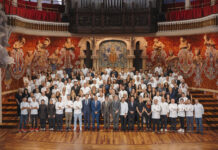Raul Luis ‘s East LA ‘Birrieria Chalio’ Serves Birria for Food Royalty with 48-hours worth of Flavor
One of East LA’s most popular restaurant serves Kings, Queens and Food Royalty. You can get a taste if it too.
Raul Luis brings Flavor with East LA’s birria
Today’s conversation has been edited for length and clarity. For the full, un-edited conversation, visit our YouTube channel here.
Joe Winger:
We have a really special treat today. We’re talking with Raul Luis from Birria the restaurant here in East LA. We’re going to talk about family. We’re going to talk about flavor. We’re going to talk about how he creates these amazing dishes. And then we’re going to talk more about how you can have a bite and taste his the food from his restaurants.
Raul Luis, thank you for joining us today.
Raul Luis:
Thank you for having me here. I’m very honored to be here speaking to you.
Joe Winger:
What’s the most important message you want the audience to hear today?
Raul Luis:
I think we can start talking about how Birria came to LA. How do we get it here? What caused that trigger to start selling the food here in LA?
My dad was given a certain skill set, handed down to him to make birria.
Birria is chivo goat meat. He used that skill set back in Mexico. He came to the U. S. when he came over during the Bracero program. He was talking to his buddies and he told them he’s a Barriario. He doesn’t know how to cook birria. So they would ask him if he would cook that dish from because that dish was only traditionally eaten during those special once in a lifetime events, baptisms, quinceañeras, weddings.
So the common denominator in all those events was the birria.
You went [to an important life event], you knew you were going to have birria. I tell people the story because I remember being small myself when I was young, that we wouldn’t eat meat too often because we were vegetarians, not by choice, but because of circumstance.
When someone was having a party, we said, “Wow, we’re going to eat birria today.” We knew we look forward to, we’re going to eat meat. It’s time. Let’s get ready to go eat some meat. Get ready, put on your Sunday clothes and go. When my father came to the U S People knew about him. They asked him to cook their dish for him.
When he cooked the meal for someone’s wedding, quinceanera, baptism, for their special occasion, he would cook extra.
So his friends would come over. When his friends would come over, he would serve whatever portion it was, usually like a whole carcass of lamb, 50 pounds. And then there was some leftover, so he would feed his friends.
And he would tell the stories when he would feed his friends. His friends wouldn’t leave. They would stay there for hours and they would be talking and my dad was, “I gotta go do my Sunday [errands], my day off. We gotta go to our family. They were there for hours and all their memories, all memories, special occasions.
Remember this? Remember that? And my dad said, “Man, what? Why are you talking? Why are you staying here so long?
It was the food.
He didn’t realize the time. It was the food that was triggering those special [memories], triggering their mind.
They’re time travelers, they’re going back to other special events.
I tell people, it’s those once in a lifetime events that are much more exponential, much more magnified because it was somebody’s wedding. It was somebody’s baptism.
That’s how it began, by cooking.
Joe Winger:
Your father was an amazing person. Back in the early 1960s, back in Mexico, he’s working in a tiny little five chair restaurant in the Mercado before migrating here to the US.
What have you learned from him taking this huge life journey?
Raul Luis:
I look back, how do the immigrants do this? How do they leave their country, leave everything behind?
He had a small spot, maybe five people to sit there. He would sell on the weekends. Business wasn’t that brisk.
They were opening up a new spot, but they required a down payment to secure it. So he had to come to the U.S. so he could save up some money.
They asked, does anyone know how to cook? Dad raises his hand. I’m a birriero.
So he began cooking birria for the farm workers. He was limited because now he was out of his comfort zone.
He was no longer in Mexico. He didn’t have access to all the spices that he used back home.
In the preparation of the different birrias, before they put the red adobe sauce, it’s white.
All the farm workers ate it up, but the people who were in charge wouldn’t eat it because it wasn’t easy on the eyes. People eat with their eyes.
[So he changed his process]
Why don’t you add the red before?
So, we marinated before we cook it,
[The second change]
There wasn’t all the spices we needed, so the chef that was there helped them get new spices or tweak the recipe a bit.
That’s what happened.
You have aspirations, and dreams, as many immigrants. They come to the U. S., make some money, go back.
He never went back.
Once you plant roots, then it’s hard to go back to your country of origin.
Joe Winger:
Fast forwarding to the present day. Your Birria in East LA is very popular.
What’s the most common dish at the restaurant?
Raul Luis:
We’re known for Birria. 9 out of 10 plates will be the Birria.
Sometimes we have new customers who want to try it but are hesitant. I explain our 10-hour cooking process [to get them excited.] Underground pits, cooking it with the mesquite wood to add that flavor.
The gaminess, the taste, our process, all that fun stuff, secrets.
Raul Luis ‘s East LA Birrieria Chalio most popular dish
Joe Winger:
Can you walk us through the flavor and process?
Raul Luis:
It’s a 2-day process. You get the [goat] carcass, cut it up into pieces.
The ribs, the neck bone, the French rack. There’s all these different cuts. Every single cut has a different taste profile and texture. So when you walk in, it depends on you. How dirty do you wanna get?
Do you wanna get down and dirty? You get the bones.
I tell people the neck is the best because it’s so tender, so soft, not too much fat on it.
If you’d like the nerve, then you get the ribs.
The flavor is amazing. In the bones, it’s amazing.
There’s people who don’t like to deal with the struggling or getting dirty. So they go with the all leg meat. That’s the drier part. It’s good, but it’s not. Not my first choice.
We cook it, we steam it, we marinate it, let it sit for about 24 hours and we put it into a our pressure cooker.
Part of the science is the way you stack it up, like a pyramid, and then they put firewood under it. If you don’t stack it correctly, part of it won’t cook.
You have to put it up a certain way to make sure that all the meat gets cooked properly.
We take it out. We’ve got to separate it so we can have all the different parts. Distinguish the leg from the neck bone from the ribs, put that aside. Then we put it in the oven so we can get like a slow roast, nice little crispy. Tender on the outside, real soft on the inside.
The most important thing is the consommé.
That’s the broth, we call it the “honey”. You can’t have it without the consomme. The birria isn’t birria without the consommé. That’s what gives it the flavor. That’s what takes it to the next level.
Some people say, “Oh, I had birria.” No you didn’t. That was a taco.
No, you’ve got to have it with the consommé.
The new movement with the birria, they dip the sauce. It’s the same concept, but I would like to think that our consommé is a little more intense, more flavorful, because we use the broth from the goat and from the mince that it distills.
So it’s really flavorful. You got to try it.
Joe Winger:
You have a deep family history, you have a cultural history. Obviously food is part of that history. Can you talk a little bit about the cultural value and the meaning behind Birria and why it’s important to you?
Raul Luis:
I tell people it’s made to feed kings and queens. How?
Because in our region, Central Mexico, the birria is eaten by most of the population in Mexico. About 85-90% are Catholic.
So one of the first steps when a child is born, they take them to the church and that’s where he becomes a king.
They baptize them. They have a festivity. There’s a party going on.
Then the second phase is they feed the Quinceaneras.
That’s a rite of passage where you go from childhood to adulthood for the girls. So now you feed the princesses.
The next step is when the lady gets married, she’s the queen.
All three of those things, traditionally, was birria.
That’s the only thing that was in common. That helped people look back to those special occasions. When people eat the birria, they go back to that once in a lifetime event.
It’s time traveling for them.
It’s the memories.
Fast forward to when we came to LA, the parents would bring their kids, [and now their kids say] ”I used to come here 20 years ago. My dad used to bring me when I was a kid.”
So that’s what it does. It brings the family together.
Raul Luis East LA Birrieria Chalio battles Fast Food Giants …and Wins (kinda)
Joe Winger:
You mentioned some fast food places now working within the same cuisine. Rubbing you the wrong way.
Raul Luis:
Yeah, it’s fascinating how many people called me [about it].
Del Taco and a few other places that were selling birria, but they’re not selling it the way it’s supposed to be. That’s wrong. At first I was a little worked up explaining that they’re missing the point here. What it means to the people from back in Mexico.
But there’s always a silver lining. Now the dish is mainstream.
I would have never been able to do that. These guys with these big budgets are able to cross over and speak to different generations, different ethnic groups.
Before, when we first opened up our restaurant. [Everyone would ask] “What’s it called? What is that? I don’t know what that is.”
Now people know when before they didn’t.
So I give them credit for being able to make people aware and bringing attention to this dish.
I see myself as the missing link. I’m the one that’s going to fill in the gaps to tell what the dish really means, what significance it has, what historical cultural value it has. That’s what I’m doing with our YouTube channel at Birria World.
Joe Winger:
Let’s talk about the Birria movement. Everyone says you are the leader. What does the future of Birria look like in East LA and in the country itself?
Raul Luis:
In a perfect world, everybody would switch over from beef to goat, which is actually one of the most eaten meats across the world.
If you go to the Middle East or China, they eat that dish. Here in the U. S., it’s not as popular.
Introducing them to the dish so they can try out the different textures, different profiles. They can see that there’s another option.
I source from a vendor in Texas.
The meat we use is paleo certified. It’s halal, all this special stuff. Probably a little more nutritional than beef.
There’s more taste, more flavors in the meat.
My job is to go out there and have people be aware that [this] exists.
There’s potential growth across the US to be provided for different ethnic groups and different generations of people.
Joe Winger:
You’ve had world-famous food stars visit you.
Raul Luis:
Anthony Bourdain came to our LA location. I guess he saw something before everybody else did and realized it was a special dish.
The second person was Jonathan Gold. He was a writer for the LA times. He wrote beautiful articles on us. He also saw what the dish meant to our community.
They gave it a little approval. Come on, try it. Take your turn. I’m sure you’ll enjoy it. I’m sure you’ll be back
Joe Winger:
Raul Luis with his Birria restaurant in East LA. Tell us all the ways that our audience can find you and learn more about you.
Raul Luis:
They did a documentary, “Mexi Papa: Chronicles of Birria” on YouTube. That’s just the basic history of how Birria got to LA and the US.
Then you can go to Birria World on YouTube. We do a birria tour, going to different restaurants, we showcase how they cook it, why it tastes different, how it’s served differently in certain regions.
On Instagram, you can go to Chalios Birria for my Texas location and East LA Chalios Birria Instagram.
Then on Facebook, it’s a Chalios Seminary.




![Why Foodies Are Obsessed With These Handmade Sourdough Pretzels [EXCLUSIVE with Misty Skolnick] Misty Skolnick co-owner of Uncle Jerrys Pretzels](https://dailyovation.com/wp-content/uploads/2025/07/Web-15-Uncle-Jerry-16-ALJ_0349-218x150.jpg)



























